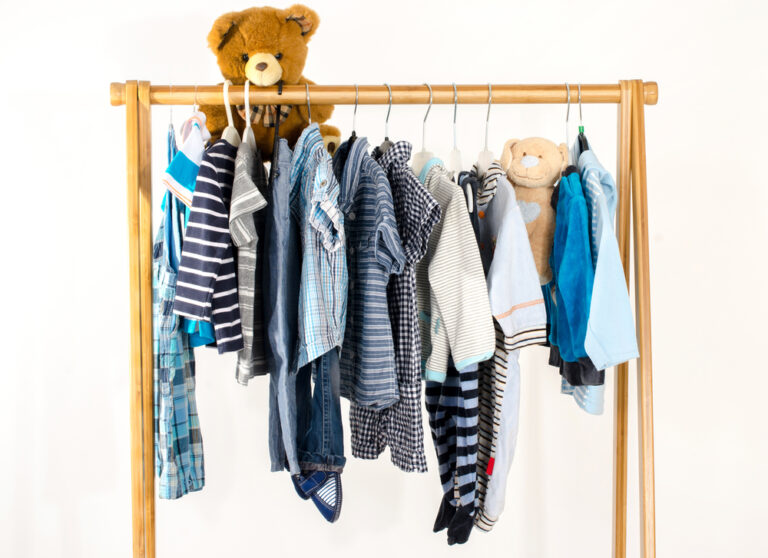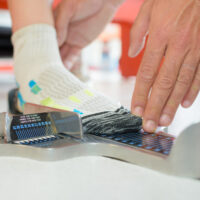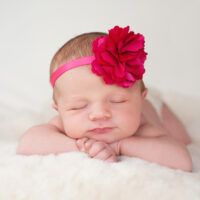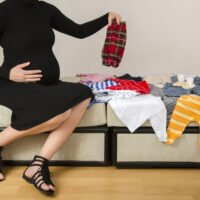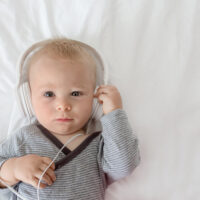The amount of clothes your little one accumulates is impressive. From onesies, jammies, nice outfits, tiny socks, mittens, bibs, burp cloths, it is easy for baby’s closet to get out of hand — fast! Whether you are busy nesting with your due date quickly approaching or you just need some help cleaning out the clutter, I will share my best tips and favorite products to make organizing your baby’s clothes easy to do, and more importantly, easy to maintain.
Step 1: Divide and Sort
Whether you are dealing with hand-me-downs, gifts, or the remnants of a major shopping spree, the first thing you want to do is organize all your baby’s clothes by size. Common sizes are newborn, 0 months to 3 months, 3 months to 6 months, 6 months to 9 months, 9 months to 12 months, and 12+ months.
Unless you have a large nursery closet and/or dresser, most moms find it easier only to have easy access to clothes that will fit within the next 6 months or so and store away larger sizes.
For instance, my sister – a mom of twin boys – saved one of everything and handed me boxes and boxes of clothes for my baby due in July. This child will have clothes from birth up to age 5! I divided everything up by size and stored sizes 12+ months and up in large crates in the garage. It is much more manageable for our space to organize clothes for only the first year.
If you have a lot of hand-me-downs, consider what your baby will actually wear. For example, if you have coats in size 6 months, but it is the heat of summer, chances are your current 6-month-old will not fit into it by the time winter rolls around. Donate the coat or save it for a future baby.
Once you have divided all of baby’s clothes by size, now separate the clothes by categories within those sizes, i.e onesies, pants, shirts, dresses, etc.
When your piles are ready to go, move to the next step!
Step 2: Evaluate Your Space
The best organizational system for you and your family will greatly depend on the space you are working with. Does baby’s nursery have a large walk-in closet or a single rod for hanging? Do you have room for a dresser? What about shelves?
No matter how tiny a space, you can still create an organization system that is easy to maintain. My daughter’s nursery was rather small, and we had to place a dresser inside her closet, which ate into our hanging space. But we were able to make it work by getting creative with storage solutions. More on that below.
Step 3: To Hang or Not to Hang
Some families like to hang all their baby’s clothes, and others find it easier to do a combination of folding and hanging. How much you are able to hang will depend on the space you have. I would recommend having at least a small dresser to hold items, such as socks, mittens, pajamas, and swaddle blankets. They are much easier to fold. If you don’t have a dresser, built-in shelves will do just fine, as well!
In my experience, here is what clothes worked best when folded and when hung. Remember, baby clothes are tiny, and hanging a onesie is not ideal, even when using kid-sized hangers.
To hang:
- Jackets
- Outerwear
- Thicker sweaters
- Dresses
- Overalls/jumpers
- Fancy/special occasion outfits
To fold:
- Onesies
- Shorts
- Pants
- Pajamas
- Shirts
- Swaddle blankets/wearable blankets
- Burp cloths
- Bibs
Those piles you made in step one will come in handy as you figure out what you want to hang and what you want to fold away in drawers.
Step 4: A Box for Everything
Now that you have an idea of what clothes you will hang and what you will fold, let’s move onto drawer organization. Because baby clothes are so tiny, things can easily get lost in drawers, even when neatly folded. That’s why having drawer dividers or drawer boxes is key to staying organized. This ensures that different items stay separated.
Drawer boxes also help make sure there is a place for everything. I like using the smaller ones to hold socks or bibs. The larger ones are great for storing pajamas, pants, shirts — any of the categories that you divided in the first step of baby clothes organization. Here’s a helpful tip: I found that rolling clothes, like pants, shirts, and onesies, was easier than folding the items flat. Rolling clothes saved space and made it easier to see all the clothes in the drawer at once. Otherwise, I would forget what I have!
As mentioned above, my daughter’s nursery was so small that we had to put the dresser in her closet, but it ended up working great. The dresser looked similar to this one, with two small drawers at the top and four larger drawers on the bottom.
Here’s how I organized each drawer:
- Top left: I stored socks, bibs, and pacifier clips. Each category was separated into its own drawer box.
- Top right: Hair accessories, bows, headbands and hats were organized in this drawer organizer by mDesign.
- First drawer: shorts, shirts, onesies rolled up and placed in separate drawer boxes
- Second drawer: pajamas and seasonal clothes (sweaters, long sleeve shirts, long pants, etc) in the same size
- Third drawer: Clothes in the next few sizes up. This drawer was the least organized of them all since it was more storage items that I did not need to access every day. I made sure to group all the clothes in the same size together, so I could rotate them into my current organization system once my daughter grew into them.
- Fourth drawer: first-aid items, back stock toiletries, and extra towels
I hung dresses, outerwear, and jumpers on the single rod in the closet. Now that my daughter is a toddler, I am hanging more of her clothes. However, I have organized my son’s nursery closet in the same method above.
Step 5: Think Outside the Box
Take stock of what you have at home and see if you can use it to organize your baby’s closet.
For instance, I had a hanging shoe organizer similar to this one that I was no longer using. I repurposed it and hung it in my daughter’s closet to hold swaddle blankets and crib sheets. This has been great to store bulkier items and allowed us to save precious drawer space.
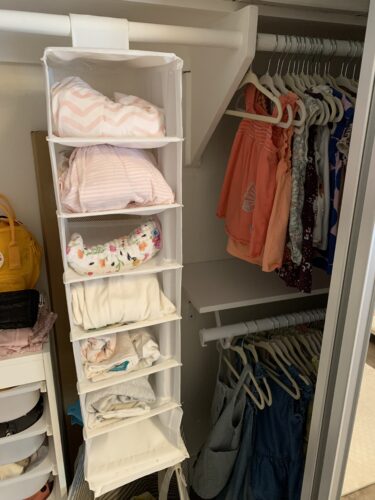
I am also utilizing every square inch of space in my daughter’s closet, including the walls! I recently purchased the IKEA Skadis Pegboard and corresponding accessories, such as hooks, clear containers, and trays, to display and organize her hair bows, sunglasses, hats, masks and more. (We use the same system in the playroom to organize art supplies!)
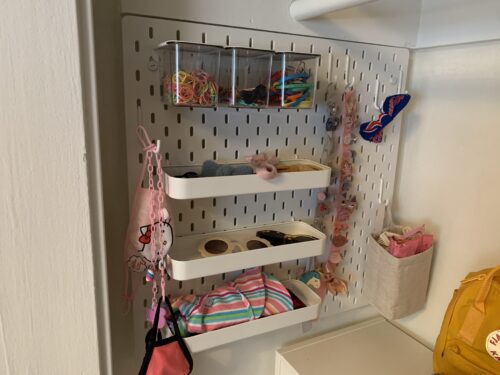
It may be unconventional, but it works great! Don’t limit yourself and think outside the box when tackling an organization project.
Step 6: Maximize Vertical Space
Your baby’s nursery closet may not be very wide or deep, but it is a safe bet to say that the space is fairly tall — at least as tall as the room itself. Use this space to your advantage. Yes, it may require getting a step stool to access items, but you can store items that you don’t reach for every day.
Adding shelves is easy and inexpensive. Vertical storage is a great place to keep clothing items that are too large or too small (more on each of these categories in Step 7 and Step 8 below) that are important to have within arm’s reach but that you won’t be needing on a daily basis.
Step 7: Out of Sight — Not Out of Mind
Now that we’ve covered how to organize the items your baby will wear and use on a daily basis, what about all those piles of clothes from step 1 that don’t quite fit your baby yet? The key here is to keep them within reach so you do not forget about them!
I am a big believer in being able to see as many of baby’s items as possible, even if it is storage. The best way I’ve gotten a handle on this is to fold away clothes that are too big in clear utility boxes. You can even find boxes that will slide underneath baby’s crib or that you can stack on top shelves in the closet. It helps to label the boxes with the clothing sizes, so you don’t have to open them up and dig around.
If you are tight on space, consider vacuum sealing baby’s clothes together by size.
You’ll save yourself time later if the clothes are washed and folded. That will make them easier to sift through once your child grows into them. Hopefully, you will be able to use your existing closet and dresser organization and simply replace clothes with new sizes.
Step 8: Empty Boxes to Stay Organized
It is a good idea to have one or two empty boxes in the closet to quickly store clothes that have become too small. This way, you’re not keeping them hanging or folded in drawers, taking up coveted real estate! Take note of what you would like to save or donate (this is why two boxes come in handy).
These boxes can be tucked away in the corner of baby’s closet or under baby’s crib. You won’t need to access them every day, but it is helpful to have a place to put everything — even clothes that your child no longer wears!
Great Products that Help
We’ve already mentioned several functional pieces to make organizing your baby’s closet and dresser simpler. Here are a few more ideas and options.
Velvet Hangers
A surefire way to save space inside any closet is to use velvet hangers instead of plastic or wire ones. They are less bulky and take up less room on the closet rod. Velvet hangers also do a better job of gripping tiny baby and toddler clothes, so they’re not constantly slipping off.
This 30 pack from Zober Premium is a great value. The velvet hangers are 11 inches wide and have a swivel hook for convenient hanging.
Double (or Triple) Hang Closet Rod
Instantly double or triple the amount of hanging space you have by adding extra closet rods to your existing rod. Because baby and toddler clothes are so small, you can easily add a second or third bar without worrying about clothes sweeping the floor.
This ClosetMaid Double Hang Closet Rod is great because you can adjust the hanging length as baby grows. The height is adjustable from 21 inches to 37 inches. It is easy to install, as well. Simply clip the rod on the existing rod using the elastic bands.
The adjustable 2-tier closet rod from Oceanstar adds two horizontal hanging rods to your space. Again, this will work best for baby, toddler, and kids’ clothes that are short enough. This is also great for bigger kids to be able to reach for jackets and other items they need when they run out the door.
Over the Door Hanging Storage
When we say utilize every inch of closet space, we mean it!
If you have doors that swing open to your closet (in lieu of sliding doors), consider an over-the-door organizer. I love this one from the Simple Houseware Store because it has clear windows, making it easy to know what’s stored inside.
This would be a great option to hold extra diapers, wipes, blankets, shoes, pacifiers, and more. If you have two doors to the closet, add an over-the-door unit to both doors and you’ve doubled your storage!
Clothing Rack Size Dividers
If you primarily hang your baby’s clothes, what better way to organize than how retail stores do it? Use these handy and adorable size dividers by pikkuboo to sort through baby’s clothes and help you stay organized.
Drawer Dividers
We talked about these above, but it’s worth mentioning again. Adjustable drawer dividers like the ones from Diommell are game-changers when it comes to dresser organization.
They expand and retract to fit your specific dresser. The dividers are spring-loaded and lock into place securely without the need for hardware or tools. You can customize the exact size partition you need for baby’s folded items.
If your dresser drawers are uniquely sized or if you find that drawer boxes don’t fit your needs, give these dividers a try. You may end up purchasing them for every room in your home!
Drawer Boxes
If you decide to go the drawer box route, luckily you have many, many options to choose from.
Find drawer boxes that are flexible, so you can squeeze several into each drawer. I love that you can find drawer boxes in almost every size to accommodate various items. A starter kit like the Diommel 12 Pack Foldable Cloth Storage Boxes is a great value to get you started.
Another good option is a drawer box that comes with dividers itself. This 24 cell drawer divider by Simple Houseware is the perfect organizer for onesies or pants. Each item gets its own compartment and you can see all your baby’s clothes at once.
Clothing Storage Bins
As mentioned throughout this article, storage bins are very helpful to have on hand to hold items that do not fit your baby quite yet or to put too small clothing that you plan to donate.
The Soft Stackable Fabric Closet Storage Organizer Holder Box by mDesign is great because it comes with a clear window that allows you to see what is inside the box. You could even adhere a label to the window, indicating the clothing sizes stored inside the box. I love that they are stackable and come in adorable colors that look decorative, as well!
If you are limited on space, consider vacuum storage for baby’s items. It comes with the extra step of having to use a hand pump to suction out the air. But the results are amazing! You can compress clothing at more than 80 percent of the size. This vacuum compression storage system also protects clothes from moisture, dirt, insects, mold, odors and more.
Once clothing is compressed, you can easily stack the piles of clothes until your baby is ready to use them.
Final Word
How you choose to organize your baby’s items is based on your unique personality. We hope this article provided general guidelines and a good starting point before you tackle this project.
The most important thing to keep in mind is to create an organizational system that you can maintain. You don’t want to spend time designing a functional space only to have it descend into chaos once more after a few weeks or months. Take time to find what works best for you.
Happy organizing!
